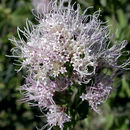Comments
(
İngilizce
)
eFloras tarafından sağlandı
Ageratina occidentalis is the only species of the genus in the flora area with sessile-glandular cypselae; peduncles also may be sessile-glandular. Its identity also can be confirmed among flora area species by its relatively long (5–6 mm) corollas.
- lisans
- cc-by-nc-sa-3.0
- telif hakkı
- Missouri Botanical Garden, 4344 Shaw Boulevard, St. Louis, MO, 63110 USA
Description
(
İngilizce
)
eFloras tarafından sağlandı
Perennials or subshrubs, 15–70 cm (caudices woody, rhizomatous). Stems (green or purple) erect or ascending, puberulent. Leaves opposite proximally, alternate on distal 1/4–1/2 of stems; petioles 5–12 mm; blades triangular to ovate, 2.5–5 × 1.7–4 cm, bases truncate to cuneate, margins serrate, apices acute, abaxial faces gland-dotted. Heads clustered. Peduncles 2–5 mm, minutely puberulent. Involucres 3–3.5(–4) mm. Phyllaries: apices acute, abaxial faces viscid-puberulent and/or sessile-glandular. Corollas pink, bluish, or white tinged with purple, lobes glabrous or glabrate. Cypselae sessile-glandular. 2n = 34.
- lisans
- cc-by-nc-sa-3.0
- telif hakkı
- Missouri Botanical Garden, 4344 Shaw Boulevard, St. Louis, MO, 63110 USA
Synonym
(
İngilizce
)
eFloras tarafından sağlandı
Eupatorium occidentale Hooker, Fl. Bor.-Amer. 1: 305. 1833
- lisans
- cc-by-nc-sa-3.0
- telif hakkı
- Missouri Botanical Garden, 4344 Shaw Boulevard, St. Louis, MO, 63110 USA
Ageratina occidentalis
(
İngilizce
)
wikipedia EN tarafından sağlandı
Ageratina occidentalis is a species of flowering plant in the family Asteraceae known by the common name western snakeroot or western eupatorium.[3] It is native to the western United States where it grows in several types of habitat. It is found in California, Oregon, Washington, Idaho, Montana, Nevada, and Utah.[4]
Ageratina occidentalis is a rhizomatous perennial herb growing fuzzy green or purple stems to a maximum height near 70 centimeters. Its leaves are glandular and triangular, with serrated edges. The inflorescence is a dense cluster of fuzzy flower heads containing long, protruding disc florets in shades of white, pink, and blue. There are no ray florets. The fruit is an achene a few millimeters long with a rough, bristly pappus.[5]
Etymology
Ageratina is derived from Greek meaning 'un-aging', in reference to the flowers keeping their color for a long time. This name was used by Dioscorides for a number of different plants.[6]
The name Eupatorium comes from the Greek king Mithridates Eupator, who is said to have discovered that a species in the genus could be used as an antidote to a common poison.[7]
In popular culture
This article was the topic of conversation in the second episode of series one of the web series "Two Of These People Are Lying" hosted by The Technical Difficulties. [8]
References
-
^ "NatureServe Explorer - Ageratina occidentalis". NatureServe Explorer Ageratina occidentalis. NatureServe. 2022-06-22. Retrieved 22 Jun 2022.
-
^ "Ageratina occidentalis (Hook.) R.M.King & H.Rob.". The Global Compositae Checklist (GCC) – via The Plant List. Note that this website has been superseded by World Flora Online
-
^ Nesom, Guy L. (2006). "Ageratina occidentalis". In Flora of North America Editorial Committee (ed.). Flora of North America North of Mexico (FNA). Vol. 21. New York and Oxford – via eFloras.org, Missouri Botanical Garden, St. Louis, MO & Harvard University Herbaria, Cambridge, MA.
-
^ "Ageratina occidentalis". County-level distribution map from the North American Plant Atlas (NAPA). Biota of North America Program (BONAP). 2014.
-
^ Keil, David J.; Powell, A. Michael (1993). "Ageratina occidentalis". In Hickman, James C. (ed.). The Jepson Manual: Higher Plants of California. University and Jepson Herbaria.
-
^ Gledhill, David (2008). "The Names of Plants". Cambridge University Press. ISBN 9780521866453 (hardback), ISBN 9780521685535 (paperback). pp 39
-
^ Blackwell, Laird R. (2006). Great Basin Wildflowers: A Guide to Common Wildflowers of the High Deserts of Nevada, Utah, and Oregon (A Falcon Guide) (1st ed.). Guilford, Conn.: Morris Book Publishing, LLC. p. 56. ISBN 0-7627-3805-7. OCLC 61461560.
-
^ Parading Around The Parish | Two Of These People Are Lying 1x02 | The Technical Difficulties, retrieved 2023-01-08

- lisans
- cc-by-sa-3.0
- telif hakkı
- Wikipedia authors and editors
Ageratina occidentalis: Brief Summary
(
İngilizce
)
wikipedia EN tarafından sağlandı
Ageratina occidentalis is a species of flowering plant in the family Asteraceae known by the common name western snakeroot or western eupatorium. It is native to the western United States where it grows in several types of habitat. It is found in California, Oregon, Washington, Idaho, Montana, Nevada, and Utah.
Ageratina occidentalis is a rhizomatous perennial herb growing fuzzy green or purple stems to a maximum height near 70 centimeters. Its leaves are glandular and triangular, with serrated edges. The inflorescence is a dense cluster of fuzzy flower heads containing long, protruding disc florets in shades of white, pink, and blue. There are no ray florets. The fruit is an achene a few millimeters long with a rough, bristly pappus.
- lisans
- cc-by-sa-3.0
- telif hakkı
- Wikipedia authors and editors
Ageratina occidentalis
(
Vietnamca
)
wikipedia VI tarafından sağlandı
- lisans
- cc-by-sa-3.0
- telif hakkı
- Wikipedia tác giả và biên tập viên
Ageratina occidentalis: Brief Summary
(
Vietnamca
)
wikipedia VI tarafından sağlandı
Ageratina occidentalis là một loài thực vật có hoa trong họ Cúc. Loài này được (Hook.) R.M.King & H.Rob. mô tả khoa học đầu tiên năm 1970.
- lisans
- cc-by-sa-3.0
- telif hakkı
- Wikipedia tác giả và biên tập viên

